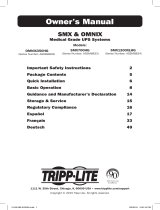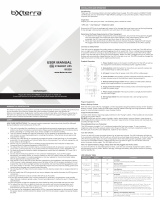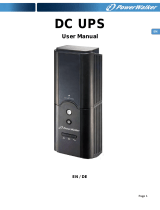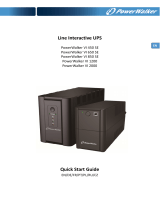
15
Guidance and Manufacturer’s Declaration
Guidance and Manufacturer’s Declaration—Electromagnetic Immunity
This Medical-Grade UPS is intended for use in the electromagnetic environment specified below. The customer
or the user of this Medical-Grade UPS should assure that it is used in such an environment.
Standard Description Test Level/Limit Guidance
EN 61000-4-2:2009 Electrostatic
Discharge
Immunity
±15 kV Air Discharge
±8 kV Contact Discharge, VCP, HCP
Floors should be wood,
concrete or ceramic tile.
If colors are covered with
synthetic material, the relative
humidity should be at least
30%.
EN 61000-4-3: 2006
+A1:2008+A2:2010
Radiated
Electromagnetic
Immunity
10V/m, 80 - 1000 Mhz
3V/m, 1 to 2.7 GHz at 80% 1kHz AM
Modulation
Mains power quality should be
that of a typical commercial or
hospital environment.
Radiated
Electromagnetic
and Proximity
Fields Immunity
RF wireless communication fields
on Spot Frequencies from Table 9 at
50%, Square wave Modulation 9 to
28 V/m,
EN 61000-3-2:2014 Power
Harmonics
230V, 50/60Hz
Class A Mains power quality should be
that of a typical commercial or
hospital environment.
EN 61000-3-3:2013 Voltage
Fluctuation 230V,
50Hz
Pst ≤ 1, dc ≤ 3.3%, dmax ≤ 6%,
d(t) ≤ 3.3% for 500ms
Mains power quality should be
that of a typical commercial or
hospital environment.
EN 61000-4-4:2012 Electrical Fast
Transient/Burst
Immunity
±2kV on AC Mains
±1 kV on SIP/SOP Ports
Mains power quality should be
that of a typical commercial or
hospital environment.
EN 61000-4-5:2006 Surge Immunity ±0.5 kV, ±1 kV, ±2kV CM Line-Gnd
±0.5 kV, ±1 kV, DM Line-Line
NA on SIP/SOP Ports
Mains power quality should be
that of a typical commercial or
hospital environment.
EN 61000-4-6:2013 Conducted
Immunity
6V rms, on ISM and Amateur bands,
3V rms, 0.15 - 80 MHz, AC Mains
and SIP/SOP Ports
Mains power quality should be
that of a typical commercial or
hospital environment.
EN 61000-4-8:2010 Power Frequency
Magnetic Field
Immunity
30A/m @ 50 Hz or 60 Hz
3 orthogonal orientations
Power frequency magnetic
fields should be at levels
characteristic of a typical
location in a typical
commercial or hospital
environment.
EN 61000-4-11:2004 Voltage
Dips, Short
Interruptions
and Voltage
Variations
Immunity
0%, 0.5 Cycles, 0%, 1 Cycle
70%, 30 Cycles, 0%, 300 Cycles
Mains power quality should be
that of a typical commercial or
hospital environment.
EN 61000-2-2:2004 Power Line
Harmonics and
Inter-Harmonics
Single sinusoidal source of 10V rms,
slowly varied from 140 to 360 Hz.
Mains power quality should be
that of a typical commercial or
hospital environment.
18-09-528-9333A2.indb 15 10/16/2018 10:33:30 AM























